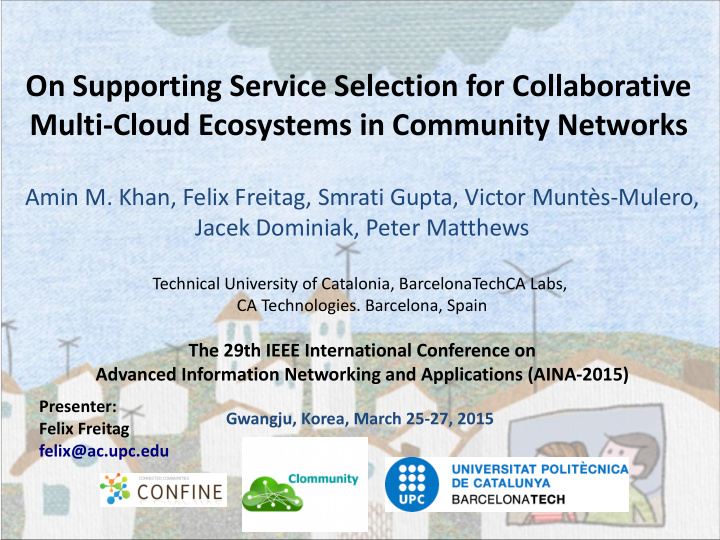



On Supporting Service Selection for Collaborative Multi-Cloud Ecosystems in Community Networks Amin M. Khan, Felix Freitag, Smrati Gupta, Victor Muntès-Mulero, Jacek Dominiak, Peter Matthews Technical University of Catalonia, BarcelonaTechCA Labs, CA Technologies. Barcelona, Spain The 29th IEEE International Conference on Advanced Information Networking and Applications (AINA-2015) Presenter: Gwangju, Korea, March 25-27, 2015 Felix Freitag felix@ac.upc.edu
Community Networks Collaboration Heterogeneous Hardware IP Network
Expected scenario
Microclouds µCloud µCloud µCloud µCloud
Several service providers µCloud µCloud µCloud µCloud
How can we help users to selects among multiple cloud service providers? We follow a practical approach : ● architecture ● build the community network cloud ● deploy real services ● address challenges
Layered architecture
Solutions chosen Solutions chosen Tahoe-LAFS, ownCloud, Peerstreamer, BitTorrent DSS Web application Service quality measurement Cloudy distro OpenStack, Eucalyptus, Proxmox, Confine KVM, LXC
Cloud Deployment
DSS Web application
Cloudy distribution Cloudy is: Debian-based Linux distribution Contains cloud services (Tinc&Avahi) and applications (Tahoe-LAFS, Peerstreamer, VoIP) Contains some CN-specific tools To be installed in VM or “bare metal” Cloudy download: http://repo.clommunity-project.eu/images/
Community cloud nodes deployed
Community cloud services (Cloudy GUI) Login Community cloud services Network services
9 different service types deployed
Several providers for the streaming service
Several providers for the syncthing service
Scanning quality of the streaming service
Scanning quality of the syncthing service
Lessons learnt Service quality for each user is location-dependent. Centralized solution needs to be extended with network and infrastructure measurements to be efficient (or using decentralized approach) For each service, different service quality metrics should be applied. Limited expressivement of technical service quality metrics for socio-technical system.
Conclusions and Future Work Community cloud deployment was shown, with several cloud services, multiple service providers. Service selection supported, using service quality estimation. Next step should involve real users to participate, understand non-technical metrics for service selection. Permanent cloud services maintained by users. Ultimately, create a community cloud service ecosystem .
A Community networking Cloud in a box clommunity-project.eu Thank you Community Cloud video Felix Freitag felix@ac.upc.edu
Recommend
More recommend